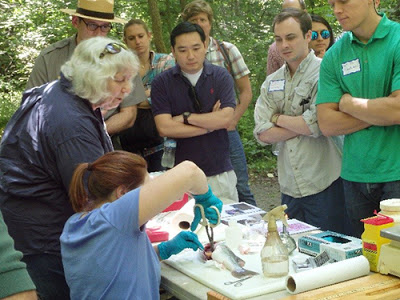Water quality experts meet in Wakefield Park to study impact on Chesapeake Bay watershed
 |
| Vickie Blazer of the USGS and her assistants dissect a fish to demonstrate the history of fish health problems in the Chesapeake Bay watershed [Fairfax County] |
About 50 people from the U.S. Geological Survey (USGS), the Environmental Protection Agency, congressional staff, and the Fairfax County Stormwater Planning Division gathered at Wakefield Park in Annandale on June 1 for an educational walking tour, the county’s Department of Public Works and Environment Services reports.
Scott Phillips, USGS Chesapeake Bay coordinator, organized the full-day field trip to demonstrate how scientific information from that agency can be used to make decisions about restoring the Chesapeake watershed.
As an “urban basin” that feeds into the bay, Accotink Creek has a big impact on the health of the bay.
At a temporary “fish station,” Vickie Blazer, of USGS and her two-person crew demonstrated the effects of toxic contaminates and endocrine-disrupting chemicals on fish health. She spoke about the differences between urban and agricultural watersheds and how USGS partners with states to collect fish samples.
Doug Moyer of the USGS’s Virginia Water Science Center and Joel Blomquist of the Maryland Water Science Center conducted a water sampling demonstration at a “water quality station.” They talked about loads and trends across the watershed and the need for continuous monitoring, innovation, publicly available data, and a focus on “unbiased science.”
Dave Anglin, a project manager with Fairfax County who oversaw the stream restorations in Wakefield Park, described how that project improved water quality in Accotink Creek.


Great story.